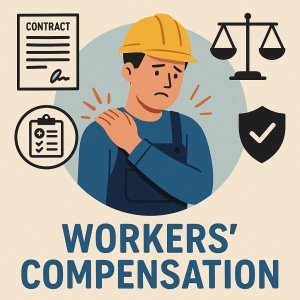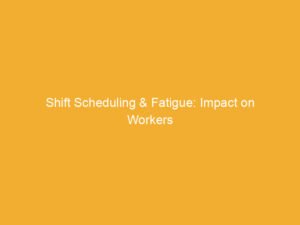
An illustration depicting workers’ compensation themes.
In today’s dynamic workforce surroundings, effective shift scheduling has emerged as a critical driver of operational efficiency and employee well-being. However, the interplay between shift patterns and worker fatigue presents meaningful challenges that extend beyond productivity concerns, directly influencing the incidence of workplace injuries and associated workers’ compensation costs. This article explores the profound impact that fatigue induced by shift scheduling can have on workplace safety, examines the resulting financial implications for organizations, and offers insights into strategic scheduling practices designed too mitigate risk and optimize both employee health and organizational expenditure.
Table of Contents
Shift Scheduling Patterns and Their Influence on Employee Fatigue Levels
Employee fatigue is considerably influenced by the type and structure of shift scheduling adopted by an organization. Rotating shifts, especially those that change quickly or inconsistently, tend to disrupt employees’ natural circadian rhythms. This disruption can lead to chronic sleep deprivation, reduced alertness, and an increased likelihood of errors on the job. In contrast, fixed shift schedules, were employees work consistent hours over extended periods, have been shown to minimize fatigue by allowing the body to adapt and maintain a regular sleep-wake cycle.Understanding these patterns is essential for companies aiming to reduce workplace accidents and the associated compensation claims.
The impact of scheduling patterns on fatigue can be summarized in the following ways:
- Quick Rotations: Often result in higher fatigue levels due to lack of adjustment time.
- Extended Night Shifts: Increase cumulative fatigue and health risks.
- Fixed Day Shifts: Offer stable circadian alignment and lower fatigue rates.
- Split Shifts: Cause fragmented rest periods, often intensifying tiredness.
Implementing fatigue-conscious scheduling not only improves employee well-being but directly correlates with reduced workers compensation costs. The table below illustrates typical fatigue outcomes by scheduling type.
| Scheduling Pattern |
Fatigue Level |
workers’ Comp Claims Impact |
| Quick Rotations |
High |
Increased by 35% |
| Extended night Shifts |
Very High |
Increased by 50% |
| Fixed day Shifts |
Low |
Decreased by 20% |
| Split Shifts |
Moderate |
Neutral |
Correlation Between Worker fatigue and Increased Compensation Claims
Studies consistently highlight a strong link between worker fatigue and a surge in compensation claims. When employees operate under chronic tiredness, their cognitive functions and physical coordination deteriorate, leading to a higher probability of errors and workplace accidents. This fatigue-induced decline not only jeopardizes worker safety but also inflates operational costs through increased medical leave, insurance premiums, and legal expenses. Companies with poorly optimized shift schedules, especially those involving irregular or extended working hours, often face a disproportionately large number of compensation claims, reflecting the hidden financial burden of neglecting workforce well-being.
Key factors contributing to this correlation include:
- Disrupted circadian rhythms that impair alertness during critical work periods.
- Reduced reaction times leading to mishaps in fast-paced or hazardous environments.
- Heightened stress levels causing diminished focus and increased risk-taking behavior.
The table below summarizes recent data from industry reports illustrating the proportional rise in compensation claims relative to average hours worked beyond standard shifts:
| Average Overtime Hours |
Increase in Claims (%) |
Employer Cost Impact |
| 5-10 hours/week |
15% |
Moderate |
| 10-15 hours/week |
30% |
High |
| 15+ hours/week |
50%+ |
Severe |
Fatigue-related work incidents impose significant financial burdens on organizations, particularly through increased workers’ compensation claims and associated costs. When employees work long or irregular shifts, their cognitive function and reaction times frequently enough decline, resulting in a higher probability of accidents. This leads not only to direct medical expenses and indemnity payments but also to indirect costs including lost productivity, retraining, and potential legal fees. Companies must quantify these impacts to understand how fatigue-driven risks translate into tangible economic consequences.
To provide clarity, consider the following comparison of average workers’ compensation costs associated with fatigue-influenced incidents versus non-fatigue incidents:
| incident Type |
Average Claim cost |
Lost Workdays |
Return-to-Work Time |
| Fatigue-Related |
$22,500 |
15 days |
4 weeks |
| non-Fatigue Related |
$12,300 |
7 days |
2 weeks |
Key financial implications include:
- Increased claim severity due to impaired worker performance and delayed incident recognition.
- Greater administrative overhead linked to managing fatigue-related claims.
- raised premiums from insurers responding to higher risk profiles.
- Potential reputational damage impacting talent retention and recruitment costs.
strategic Scheduling Solutions to Mitigate Fatigue and Control Compensation Expenses
Organizations facing the challenge of balancing operational demands with employee well-being can leverage targeted scheduling strategies to reduce fatigue-related risks. Incorporating rotational shift designs that allow sufficient recovery time between shifts and prioritizing consistency in shift assignments can significantly enhance alertness and reduce error rates. Moreover, integrating predictive analytics into scheduling decisions helps identify high-risk patterns, enabling managers to proactively adjust workloads before fatigue accumulates.
Effective scheduling solutions also have a direct impact on controlling workers’ compensation expenses. By minimizing fatigue-induced incidents, companies can reduce injury claims, legal costs, and insurance premiums. Some best practices include:
- Implementing flexible shift start times to accommodate individual circadian rhythms.
- Limiting consecutive night shifts to prevent chronic sleep deprivation.
- offering rest breaks strategically during extended shifts to maintain focus.
| Scheduling Approach |
Fatigue Reduction |
Estimated Cost savings |
| Fixed Shifts |
moderate |
10-15% |
| Rotational Shifts with Recovery Days |
High |
20-30% |
| Predictive Analytics Scheduling |
Very High |
35-45% |
Q&A
Q&A: Shift Scheduling & Fatigue – Impact on Workers Compensation Costs
Q1: Why is shift scheduling vital in the context of workers’ compensation costs?
A1: Shift scheduling directly influences employee fatigue levels, which affects workplace safety and overall health. Poorly designed schedules that lead to excessive fatigue can increase the likelihood of accidents and injuries,thereby driving up workers’ compensation claims and associated costs.
Q2: How dose employee fatigue contribute to workplace accidents?
A2: Fatigue impairs cognitive functions such as attention, decision-making, and reaction time. When workers are fatigued, they are more prone to errors and less able to respond effectively to hazards, resulting in higher rates of accidents, injuries, and ultimately, workers’ compensation claims.
Q3: What scheduling practices are linked to increased fatigue?
A3: Scheduling practices that contribute to fatigue include long shifts (exceeding 10-12 hours), frequent night shifts, quick shift rotations, insufficient rest periods between shifts, and mandatory overtime. These factors disrupt circadian rhythms and reduce recovery time, increasing fatigue risk.
Q4: Can optimizing shift schedules reduce workers’ compensation costs?
A4: Yes. Implementing evidence-based scheduling strategies-such as limiting consecutive night shifts, ensuring adequate off-duty time, and designing predictable, consistent schedules-can decrease fatigue-related incidents, thus reducing workplace injuries and workers’ compensation expenses.
Q5: What role does management play in addressing fatigue through scheduling?
A5: Management is responsible for creating and enforcing shift schedules that prioritize employee well-being. This includes involving workers in scheduling decisions, monitoring fatigue-related risks, promoting education on fatigue management, and adjusting schedules proactively based on data and feedback.
Q6: Are there technological solutions that assist in managing shift scheduling to reduce fatigue?
A6: Yes. Workforce management software can optimize shift patterns by integrating fatigue risk models and compliance rules. These tools help balance operational demands with employee health considerations, thus supporting safer schedules and potentially lowering compensation claims.
Q7: What are the broader benefits of effective shift scheduling beyond reducing compensation costs?
A7: Effective scheduling improves employee morale, reduces absenteeism, enhances productivity, and fosters a safer workplace culture. These benefits contribute to overall organizational performance and can lead to long-term financial and reputational gains.
This Q&A provides a concise yet thorough overview of the relationship between shift scheduling, worker fatigue, and workers’ compensation costs, framed for business professionals seeking practical insights.
In Summary
the correlation between shift scheduling practices and worker fatigue is a critical factor influencing workers’ compensation costs. Organizations that proactively address fatigue through optimized shift design not only enhance employee well-being but also mitigate the financial risks associated with workplace injuries and absenteeism.By prioritizing evidence-based scheduling strategies, businesses can foster safer work environments, improve productivity, and achieve significant cost savings. Ultimately,integrating fatigue management into workforce planning is a strategic investment that supports both operational efficiency and long-term organizational success.
“This content was generated with the assistance of artificial intelligence. While we strive for accuracy, AI-generated content may not always reflect the most current information or professional advice. Users are encouraged to independently verify critical information and, where appropriate, consult with qualified professionals, lawyers, state statutes and regulations & NCCI rules & manuals before making decisions based on this content.







